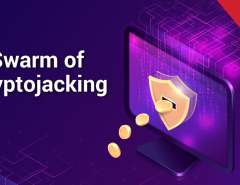If ransomware, malware, hacking and data loss weren’t enough for India’s cybersecurity space, it has now got another problem to deal with. On 11 May, 2018, it was widely reported that India had just seen a major cryptojacking attack. More than 2,000 computers from Aditya Birla company were targeted by hackers for cryptojacking. As per the reports, the attack was first detected at an overseas subsidiary and soon found its way to some of the manufacturing and service computers of the company. The reports quoted an Aditya Birla spokesperson specifying that the threat had been neutralized and that they had ascertained there was no data loss.
So what is Cryptojacking?
But if you’re a business owner, don’t get lulled into a false of security by the “no data loss” version. In fact, that’s the very point of this new, dangerous form of cyber attack. Cryptojacking attacks don’t necessarily cause data loss; they serve a more dangerous, insidious purpose. They are used by hackers to use someone else’s computer to generate or mine cryptocurrency.
In the Aditya Birla attack, the cryptocurrency that was mined was Montero which is used by many cybercriminals as it is considered to be more anonymous than the more well-known Bitcoin.
How does it work?
Hackers try and get unsuspecting victims to click on malicious links in emails or hosting a website or ad with infected code. Once the victim is infected, the code then works in the background mining cryptocurrency, sometimes without victims even noticing it.
The harmful effects
To understand how cryptojacking works, we need to also understand the basics of cryptocurrency. There are two ways to get cryptocurrency: either buy it or mine it. Mining requires computers with massive processing computer which not many can afford. Hence, this is where hackers have found a malicious way to gain cryptocurrency: use other people’s processing power to generate cryptocurrency.
But obviously, this has a side-effect. The systems which are cryptojacked operate at full capacity, resulting in high electricity consumption. The computer gets hotter, the fans get louder. This has an effect on the system as well as it can crash often, affect the company’s security and productivity. In effect, hackers are using their victim’s computers for their own personal usage and ensuring the victims also foot the electricity bill.
Are only PCs affected?
No, not really. Any browser that has JavaScript running can be affected by cryptojacking. This effectively means that desktops, laptops and even mobile devices can be affected, making almost all electric devices of a business susceptible.
What steps can be taken to prevent cryptojacking?
Obviously, the first step towards securing your organization against cryptojacking is awareness. If a business is aware of this new kind of threat, that itself goes a long way in securing their defense.
- Installing ad-blocking software on browsers
Most cryptojacking scripts are delivered through malicious code embedded in websites which users inadvertently stumble upon. Installing an ad-blocker or an anti-cryptomining software on the browser is an effective means to guard against these kinds of attempts.
- Web Filtering
Most major cybersecurity solutions offer Web Filtering tools. These web filtering tools can be customized to ensure that websites which are found suspicious of containing cryptojacking code can be blocked and users can be prevented from accessing them.
- Network Monitoring
Similarly, a network monitoring tool also helps in detecting large surges of processor activity which can be a symptom of a device being cryptojacked. Network administrators must keep an eye on the monitoring data for anomalies.
- A Mobile Device Management (MDM) solution
As mentioned previously, cryptojacking efforts also include mobile phones which business employees may use for their convenience. To prevent this kind of hijacking, a strong Mobile Device Management (MDM) solution can be useful.
Seqrite’s Unified Threat Management (UTM) solution can be a strong defense against cryptojacking efforts thanks to its advanced Intrusion Detection System and URL Filtering. For mobile devices, businesses can consider Seqrite’s Mobile Device Management (MDM) solution, thanks to key features which help to prevent cryptojacking.



